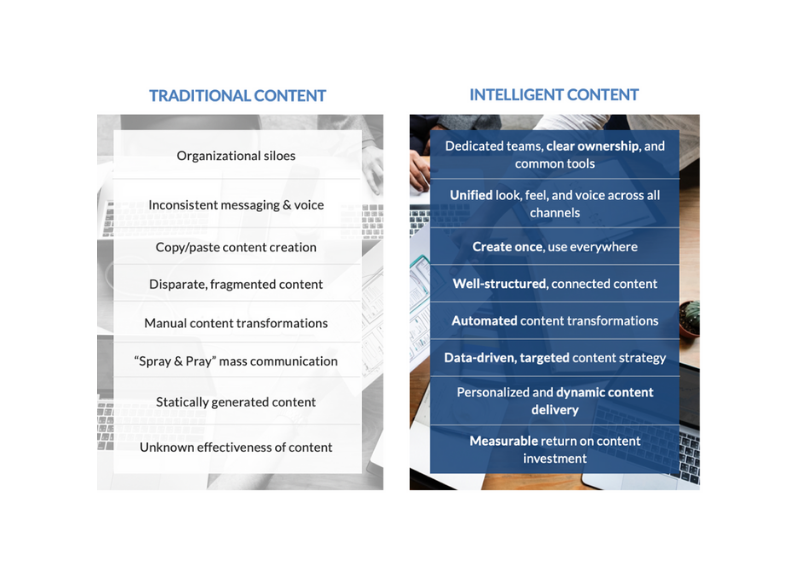
This is the third article in a series devoted to taking a closer look at the pillars for intelligent content activation: alignment, intelligence, technology, and process. This article will break down the intelligence pillar, exploring the structure and semantics that allow content to be adaptable, agile, and accurate.
In the first article in this series, we introduced the journey to intelligent content as a road trip, with each pillar of intelligent content activation as a necessary component to embark on your journey. Using this metaphor, intelligence is the fuel that powers your car. Just as you must pump the right kind of fuel into your vehicle, your content must have the necessary structure for “always on content” to be realized.
This article will outline the basics of content structure—taxonomy and metadata—and will equip you with the building blocks needed to craft your content model.
Get Organized With Taxonomy
When you hear “taxonomy,” you may have flashbacks to your middle school science class and textbooks with the animal kingdom classifications. In the context of intelligent content, taxonomies serve a similar function as in the animal kingdom—to define and organize relationships, standardize definitions, and create consistency and control.
Content taxonomies are critical because they allow for content discoverability, content reuse across organizational teams, personalization at scale, and unification of brand voice to end consumers.
Creating a taxonomy involves the identification and organization of content, as well as the definition of relationships between content based on content purposes. There is not a one-size-fits-all approach to crafting your content taxonomy. Depending on the complexity of your site, you may find that your taxonomy is a single layer (flat), multi-layered (hierarchical), or associative (network).
To better understand taxonomies, let’s use the example of an auto part ecommerce store. If you need to replace a part on your vehicle and use Pep Boys’ website, the first content you encounter is their landing page. From here, you can quickly find what you need by drilling down into their content categories, such as Services, Products, Research, and Tires. Visible categories like these can often provide insight into underlying taxonomy, although sometimes the taxonomy is invisible to users, strategically serving to relate content for maximum efficiency and personalization.
It may seem like an overwhelming exercise to classify all your content, but it’s worth it. If you’re not sure how to begin, start by asking yourself the following questions:
What content is produced by my organization?
How can this content be categorized and labelled?
What relationships exist among this content?
Add Meaning With Metadata
If taxonomy defines structure and relationships between content, metadata creates meaning. Metadata, or “data about data,” provides content with additional context by adding both descriptive and administrative dimensions behind the scenes.
Administrative metadata provides details about the structure of the content that are required for the system to be able to effectively orchestrate the content.
Descriptive metadata focuses more on the meaning of the content and its intended use to reach end users.
Let’s look at an Going back to our Pep Boys example, each piece of content on their website has underlying metadata that structures and adds meaning to it. For example, a product details page’s descriptive metadata may include manufacturer, description, product title, etc., and its administrative metadata may include published date or content creator.
Technology platforms are making it increasingly easy and efficient to add metadata to content. A leading example of this is Adobe Experience Manager (AEM) Assets, an asset management solution. AEM uses artificial intelligence smart tagging to automatically tag images with metadata about the image, cutting down on the manual effort of creating metadata.
Nonetheless, it’s important to have a plan for developing metadata to create consistency in the content structure and meaning. When defining your metadata, consider the following questions:
What administrative functions are necessary to create and manage my content?
How do I want to relate my content to reach my target consumer, and what level of detail is required to inform the meaning of my content?
What are the latest web standards (e.g., RDF/RDFa, Dublin Core, Schema.org) that I should use to inform my metadata practices and structure?
Pull It All Together in a Model
Once you’ve defined your taxonomy and have crafted your metadata approach, you’re ready to put it all together in a comprehensive content model. Content models are a key tool to creating standardization and alignment across departmental siloes, as well as maximizing content efficiency. You can think of a comprehensive content model as a framework for content organization across an entire organization, including all content types that are created by all departments in all systems.
Content models provide a holistic view of the content ecosystem, including content purpose, organization, requirements, and definitions. It pulls together your taxonomy and metadata strategies into an actionable, master set of content that is a key input into structuring content within your CMS (content management system) and ensuring consistency across your organization.
Ask yourself these questions when getting started with content model creation:
What are the reusable content elements that make up each of my content types?
What are the requirements (functional, layout, etc.) for my content that should be included in the content model?
How can I begin to create content templates that are comprised of my defined elements?
Figure 1. Creating a Content Model
Invest in Intelligent Content
Creating intelligent content requires the initial investment to inventory, organize, and structure content, but the impact is tremendous. Taking the time to get organized with your content will position you for future scalability in content production and flexibility with personalization at scale. It will also create alignment across your organization on a shared standard of content structure to ensure unification of brand voice and message to your end consumer.
If you’re curious about learning more about how your organization can benefit from intelligent content, reach out to findoutmore@credera.com.
Contact Us
Ready to achieve your vision? We're here to help.
We'd love to start a conversation. Fill out the form and we'll connect you with the right person.
Searching for a new career?
View job openings